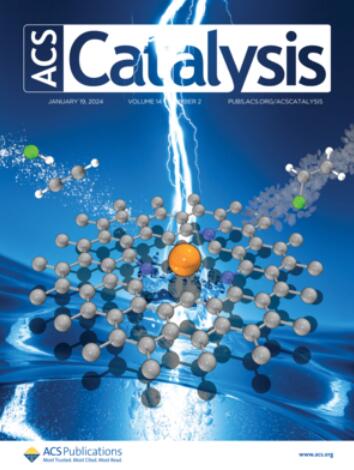工程生物合成途径生产 (+)-Brevianamides A 和 B
IF 11.3
1区 化学
Q1 CHEMISTRY, PHYSICAL
引用次数: 0
摘要
包含双环[2.2.2]重氮辛烷(BDO)核心的特殊融合环结构普遍存在于二酮哌嗪(DKP)天然产物中,表现出强大而多样的生物活性。通常,这些化合物只能从天然真菌产生菌株中提取,并且使用现有的合成途径非对映选择性地获取它们仍然具有挑战性。含有bdo的DKPs,包括(+)-短甲酰胺5a和b6,通过多酶生物合成途径组装,包括非核糖体肽合成酶、戊烯基转移酶、黄素单加氧酶、细胞色素P450和异构酶。为了简化这类生物碱的获取,我们在大肠杆菌中设计了一种工程生物合成途径,由来自不同生命领域的六种酶组成。该途径包括来自链霉菌sp. CMB-MQ030 (NascA)的环二肽合成酶,来自链霉菌sp. F5123 (DmtD2/DmtE2)的环二肽氧化酶,来自曲霉sp. MF297-2 (NotF)的丙烯基转移酶,来自短压缩青霉菌(BvnB)的黄素依赖单加氧酶,以及来自福氏杆菌和嗜酸热原体(PhoN和IPK)的激酶。在添加丙烯醇的甘油培养基中培养,工程大肠杆菌菌株产生5.3 mg/L(−)-脱氢brevianamide e4,该菌株经过先前报道的氢氧化锂重排级联反应,产率为5和6,总产率为70%,非对构象比为94:6。此外,通过增强工程菌株的NADPH池,4的滴度提高到20.6 mg/L。总的来说,我们的研究结合了从头开始的生物合成途径工程和化学合成方法来生成复杂的吲哚生物碱。本文章由计算机程序翻译,如有差异,请以英文原文为准。

Engineering a Biosynthetic Pathway to Produce (+)-Brevianamides A and B
The privileged fused-ring structure comprising the bicyclo[2.2.2]diazaoctane (BDO) core is prevalent in diketopiperazine (DKP) natural products that exhibit potent and diverse biological activities. Typically, only low yields of these compounds can be extracted from native fungal producing strains and accessing them diastereoselectively remains challenging using available synthetic routes. BDO-containing DKPs including (+)-brevianamides A 5 and B 6 are assembled via multienzyme biosynthetic pathways incorporating nonribosomal peptide synthetases, prenyltransferases, flavin monooxygenases, cytochromes P450, and isomerases. To simplify access to this class of alkaloids, we designed an engineered biosynthetic pathway in Escherichia coli, composed of six enzymes sourced from different kingdoms of life. The pathway includes a cyclodipeptide synthase from Streptomyces sp. CMB-MQ030 (NascA), cyclodipeptide oxidase from Streptomyces sp. F5123 (DmtD2/DmtE2), prenyltransferase from Aspergillus sp. MF297–2 (NotF), flavin-dependent monooxygenase from Penicillium brevicompactum (BvnB), and kinases from Shigella flexneri and Thermoplasma acidophilum (PhoN and IPK). Cultivated in glycerol media supplemented with prenol, the engineered E. coli strain produces 5.3 mg/L of (−)-dehydrobrevianamide E 4, which undergoes a previously reported lithium hydroxide rearrangement cascade to yield 5 and 6, with a combined 70% yield and a 94:6 diastereomeric ratio. Additionally, titers of 4 were increased to 20.6 mg/L by enhancing NADPH pools in the engineered strain. Overall, our study combines de novo biosynthetic pathway engineering and chemical synthesis approaches to generate complex indole alkaloids.
求助全文
通过发布文献求助,成功后即可免费获取论文全文。
去求助
来源期刊

ACS Catalysis
CHEMISTRY, PHYSICAL-
CiteScore
20.80
自引率
6.20%
发文量
1253
审稿时长
1.5 months
期刊介绍:
ACS Catalysis is an esteemed journal that publishes original research in the fields of heterogeneous catalysis, molecular catalysis, and biocatalysis. It offers broad coverage across diverse areas such as life sciences, organometallics and synthesis, photochemistry and electrochemistry, drug discovery and synthesis, materials science, environmental protection, polymer discovery and synthesis, and energy and fuels.
The scope of the journal is to showcase innovative work in various aspects of catalysis. This includes new reactions and novel synthetic approaches utilizing known catalysts, the discovery or modification of new catalysts, elucidation of catalytic mechanisms through cutting-edge investigations, practical enhancements of existing processes, as well as conceptual advances in the field. Contributions to ACS Catalysis can encompass both experimental and theoretical research focused on catalytic molecules, macromolecules, and materials that exhibit catalytic turnover.
 求助内容:
求助内容: 应助结果提醒方式:
应助结果提醒方式:


